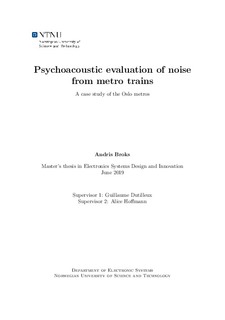| dc.contributor.advisor | Dutilleux, Guillaume | |
| dc.contributor.author | Broks, Andris | |
| dc.date.accessioned | 2019-10-26T14:04:10Z | |
| dc.date.available | 2019-10-26T14:04:10Z | |
| dc.date.issued | 2019 | |
| dc.identifier.uri | http://hdl.handle.net/11250/2624670 | |
| dc.description.abstract | De klassiske tilnærmingene som blir brukt til å analysere T-bane støy fungerer bra i de fleste tilfellene, men noen ganger forklarer de ikke hvorfor en bestemt støykilde opplevessom svært plagsom. Den nye teknologiske tiden bringer også noen nye utfordringer ettersom byene vokser raskt, og de teknologiske endringene fører til endringer i støy som blir produsert. Dermed finnes det en etterspørsel etter de nye måtene å se på de gamle problemene fra forskjellig vinkel. Psykoakustisk vurdering av støy kan utvide vår forståelse av hvordan mennesker reagerer på støykilder nå til dags. Dette arbeidet er en fortsettelse av Alice Hoffmann’s doktorgradsavhandling om psykoakustisk vurdering av trafikkstøyen, denne gangen anvendt på T-bane støy. Følgende oppgave beskriver studiet av psykoakustisk vurdering av T-bane støy i Oslo-byen, Norge. Hovedformålet med dette arbeidet var å avdekke hvilke psykoakustiske og emosjonelle parametre som kan brukes ved vurderingen av T-bane støy. Dataene som ble samlet inn fra de fire forskjellige målestedene i Oslo, ble behandlet ved hjelp av programvareberegninger og lyttetester i et kontrollert laboratoriemiljø. Den statistiske analysen viste at de teoretiske programvareberegningene og lyttingstestresultatene korrelerer ganske godt for parametrene skarphet og lydstyrke. En dypere analyse ved hjelp av enveis ANOVA-test viste at skarphet og lydstyrke er de beste blant alle psykoakustiske parametrene under vurdering for å beskrive støy fra T-banen. Ruhet og fluktueringsstyrke viste ganske dårlige resultater, og det ser ut at teoretiske modeller foreslått for disse parametrene ikke stemmer overens med den menneskelige oppfatningen som ble estimert ved hjelp av lyttetester. De emosjonelle parametrene, stress og behagelighet, kan også være verdifulle indikatorer for lydopplevelse av støy fra T-banen. Statistisk analyse viste at noen av signalene har lignende resultater uansett hvilken parameteren blir brukt, og dermed signalenes natur er avgjørende og bør vurderes når T-bane støy blir analysert. | |
| dc.description.abstract | The classical approaches used to analyze metro train noise work nicely in most cases, however, sometimes they do not explain why a particular noise source is experienced as very bothersome. The new technological era also brings some new challenges since the cities are rapidly growing and the technological changes lead to the changes in noise that is being produced. Thus, there is a demand for the new ways to look at the old problems from different angle. Psychoacoustical assessment of noise could broaden our understanding of how humans react to noise sources nowadays. This work is a continuation of the Alice Hoffmann’s Ph.D thesis on the topic of psychoacoustical assessment of the tyre-road noise, this time applied to the metro train noise. The following paper presents the study of psychoacoustical evaluation of metro train noise in the Oslo city, Norway. The main purpose of this work was to reveal which psychoacoustical and emotional parameters can be used in the assessment of the metro train noise. The data collected from the four different measurement sites in Oslo was processed with a help of software calculations and listening tests in a controlled lab environment. The statistical analysis showed that there is a good agreement between the theoretical software computations and listening test results for the parameters sharpness and loudness. A deeper analysis using one-way ANOVA test proved that sharpness and loudness are the most suitable psychoacoustical parameters to describe the metro train noise. Roughness and fluctuation strength showed rather poor results and it seems that theoretical models proposed for these parameters do not agree with the human perception that was estimated using the set of listening tests. The emotional parameters, stress and pleasantness, can also be valuable indicators of the metro train noise perception. Statistical analysis showed that some of the signals have similar results despite the parameter being used, and thus the nature of the signals can be crucial and should be considered when analyzing metro train noise. | |
| dc.language | eng | |
| dc.publisher | NTNU | |
| dc.title | Psychoacoustic evaluation of noise from metro trains | |
| dc.type | Master thesis | |
